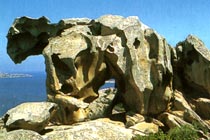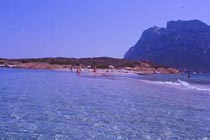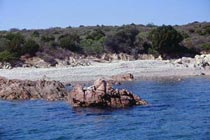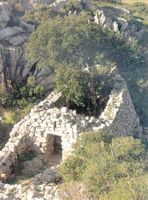THE GALLURA

| The province of Gallura is situated in the northeast side of Sardinia. It is part of the old large province of Sassari, now it constitutes the new little province of Olbia, and it is very well known for the beautiful scenery, the exceptional turquoise colors of the sea, the wind-sculpted granite rocks and the spectacular mountains of the Limbara Massif. With the passing of time, the wind and sea have smoothed and shaped these rocks into unusual animal forms, which are so striking they seem to have been modelled by artists. | |
| The most enchanting of these rock formations is Capo D'Orso at Palau, which resembles a bear. Granite is, in fact, the most representative element of the Gallura region and constitutes its unmistakable bone structure. It lies below the surface of the mountain ranges, such as the Limbara, and is exposed in the extraordinary cascades of granite boulders which form the impressive cliffs and precipices. One day the Prince Karim the 4th, heir of Mohamed and Aga Khan of the Ishmaelites, during a cruise discovered the northeastern coast of Sardinia and observing it aboard the yacht, he saw a shore with gulfs, islands and creeks still deserted and wild. He was absolutely fascinated by the vibrant colours of the sea and the bizarre shape of the wind-sculpted granite rocks. |
|
| The headlands had emerald green slopes and scented "macchia" was in full bloom with rosemary, thyme and other fragrant Mediterranean vegetation. In the early sixties a Consortium headed by the Aga Khan was founded and it was named Costa Smeralda, The Emerald Coast, which soon became the site of an ambitious new holiday venue in the Mediterranean Sea. The project transformed a coastline that is forty-three kilometres long with a surface of about five thousand hectares, into a paradise haven for the jet society. The whole Costa Smeralda area is one of the best-loved places for international tourists during summertime vacations, but also in spring and autumn because of its exceptionally mild climate. Famous architect from France like Jacques Couelle contributed in the creation of a unique and new architectural style that recalls certain rustic old houses of Sardinia with faded colours or white washed walls reinterpreting the Moorish architecture. | |
|
You want to pass the summertime vacations in this charming place, to a reasonable price, to buying or renting an house, a villa or an apartment? YOU ADDRESS To GEMINI AGENCY REAL ESTATE OF PORT SAINT PAUL BY GALLURA! |
|
 |
Gallura is also remarkable from an archaeological
point of view. It is, in fact, the heart of the culture of the Megalithic
circles, known as "circoli megalitici" or "circoli
di Arzachena". This prehistoric testimony, dating back to the
III millennium B.C., presents characteristics which are unique in
the various phases of Sardinian prehistory. The high land of Gallura stands apart from the rest of Sardinia thanks to its natural patrimony of woods, made up of oaks and cork trees, as well as a dense undergrowth of heather, strawberry and juniper bushes. The region is known for its fine handicraft, above all for the production of cork, weaving and the working of granite, but it also boasts a tradition of fishing, hunting and the production of Vermentino, a local white wine. |
| Visitors to the area will get the chance to sample the delicious types of pork meats (salami, sausages and ham), as well as various local specialities (ziminu, suppa cuata, mazzafrissa, pulilgioni), which have been prepared by the people from Gallura for generations | |
Beaches of Gallura
|
|
- The Giants' Tomb of Coddu 'Echju. This archaeological site is particularly fascinating since it dates back to a number of different historical periods, staring from the middle of the II millennium B.C., up to the Nuragic period. It is characterised by an impressive stele, or standing stone, which, at a height of 4.40 m, is the tallest one discovered up to now. |
|
 |
| In nuragic times, the pastoral community who lived in Santa Teresa had cult places, gods or heroes to worship, as testify two important archeological finds: the giants' tomb at Lu Brandali and La Testa. It' s possible to visit the archeological places in the countryside, bathed in mediterrean scrub which has protected them from destruction. How magic it is to sit in silence, looking towards the sun, inside the exhedra , that is the area opposite the tomb, just as ancient people used to do like a sort of magnotherapy. Aristotele narrates the Sardinians used to sleep at their heroes's tombs, to preserve their uncorrupted bodies. Several witnesses show how relaxing it is to stop by these places which give you a sense of peace and of wellbeing as well. | |
 |
|
|
|
|
Museum list of Gallura
|





















